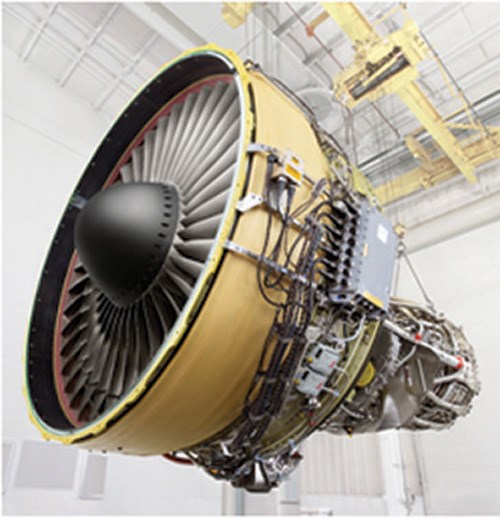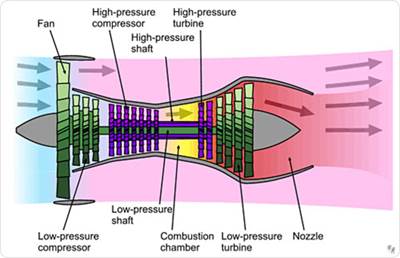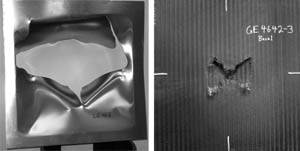Composites enable new advances in engine technology
CompositesWorld's conference director Scott Stephenson recalls a presentation at the recent Carbon Fiber 2010 conference (Dec. 7-9, La Jolla, Calif.) by Doug Ward of GE Aviation (Cincinnati, Ohio) on design trends in commercial jet engines that favor the use of composites.
At the recent CompositesWorld Carbon Fiber 2010 conference, held in La Jolla, Calif. (Dec. 7-9, 2010), Doug Ward of GE Aviation (Cincinnati, Ohio) spoke about how composite materials are earning their way onto his company’s GEnx engines — reputedly the most efficient jet engines yet designed — for a variety of aircraft, including the Boeing 787 Dreamliner. Composites are clearly proving themselves in this structurally demanding and important aerospace application.
Airlines are under increasing financial and environmental pressure to operate more efficiently with a smaller carbon footprint. Further, the aircraft operator is increasingly subject to scrutiny by surrounding communities interested in reducing noise during take offs and landings while maintaining safety and reliability standards. GE Aviation stepped up to the plate with its GEnx engine design, which will be produced in two versions for the Boeing 787 and 747-8. GEnx engines burn 15 percent less fuel and emit 85 percent less nitrous oxide (NOx) than the CF6 engines that precede them. Further, they are 30 percent quieter than the CF6. At the same time, says Ward, the GEnx engines require fewer parts — which means savings in maintenance, repair and overhaul (MRO) costs that contribute to a 30 percent reduction in cost of ownership compared to previous engines. The composites-intensive design of the GEnx means the four-engine Boeing 747-8 will have an approximate 1,550-lb (680-kg) weight reduction, equivalent to seven additional paying passengers. The design also saves about 660,000 gallons (2.5 million liters) of jet fuel per year, per aircraft.
What made these vast improvements in engine performance possible? Ward says, “Engine core sections have become smaller, thanks to better materials and design in the hot section and advances in cooling technology — but that means that fans are becoming larger for better propulsive efficiency.”
During jet engine operation, a portion of the air that passes through the fan inlet is compressed and burned in the combustion core chamber and expelled as a high-velocity exhaust jet. But a greater proportion of the air bypasses the core, pushed rearward by the fan through the bypass fan duct. The bypass fan air generates the majority of thrust for these high-bypass engines. The larger the amount of air that travels through the fan bypass duct compared to the engine core, the higher the bypass ratio. The higher the bypass ratio, the lower the fuel burn rate, plus less noise is generated because the larger bypass airflow helps mask the noise generated by the core’s exhaust. GEnx engines have a bypass ratio of 9.5 — an early 1950s-era jet engine’s bypass ratio was 0.3, for comparison — which means that the fan now constitutes 33 percent of the engine’s weight, reports Ward.
Fan blade weight, it turns out, has become a significant driver of change in propulsion system weight. For example, a 1-lb/0.45-kg increase in fan blade weight requires a corresponding 1-lb increase in containment case weight, a 0.5-lb/0.23-kg increase in rotor weight, and so on, causing weight increases to cascade throughout the engine system. The trend toward larger fans thus drove the need for lighter materials. “Carbon/epoxy materials for fan blades simultaneously reduce fan weight and improve durability as compared to metallic structures,” explains Ward, by offering increased specific stiffness, lower density, better fatigue strength and, most importantly, improved damage and defect tolerance.
GE Aviation started to incorporate composites into its fan blades about a decade ago. But in the GEnx engine, composites have enabled the design of larger blades, with more effective aerodynamics than could be produced with previous materials. Therefore, the fans require fewer blades. In fact, only 18 fan blades are required for the GEnx fan. By comparison, the GE CF6 engine’s fan has 36 blades. This difference provides designers the opportunity for additional weight savings.
Other composites in the GEnx, reports Ward, include the containment case, which is reinforced by carbon fiber braid. The GEnx is the first jet engine to use a composite front fan case. The fiber is Toray (Tokyo, Japan) T700 standard modulus, braided by A&P Technology (Cincinnati, Ohio). The containment case weighs 700 lb/318 kg less per two-engine aircraft than a metal case and requires no hexavalent chromium coating because galvanic and other corrosion concerns are eliminated. Additional compoRead the full story about the GEnx jet engine’s “Composite fan blade containment case,” in the HPC Focus on Design feature lsited under "Editor's Picks," at right). Looking ahead, Ward told conference attendees that GE is assessing ceramic matrix composites for use aft of the fan case to meet the challenge of heat because temperatures range from 1000°F to 2000°F (538°C to 1093°C).
Ward says GE is considering composites in more engine components in the future to gain even greater weight savings. Although composite materials enable higher bypass-ratio turbofans, with outstanding damage tolerance and residual strength, he noted that, as always, material cost is the greatest hurdle preventing further penetration of composites in the aviation engine market.
Related Content
Thermoplastic composites welding advances for more sustainable airframes
Multiple demonstrators help various welding technologies approach TRL 6 in the quest for lighter weight, lower cost.
Read MoreComposite rebar for future infrastructure
GFRP eliminates risk of corrosion and increases durability fourfold for reinforced concrete that meets future demands as traffic, urbanization and extreme weather increase.
Read MorePlant tour: Albany Engineered Composites, Rochester, N.H., U.S.
Efficient, high-quality, well-controlled composites manufacturing at volume is the mantra for this 3D weaving specialist.
Read MoreCarbon fiber in pressure vessels for hydrogen
The emerging H2 economy drives tank development for aircraft, ships and gas transport.
Read MoreRead Next
Aviation Outlook: Composites in commercial aircraft jet engines
Airlines' need for fuel-efficient flight provides the thrust behind composite lightweighting strategies in jet engine manufacturing.
Read MoreComposite fan blade containment case
Innovative use of carbon-fiber braid yields a ductile structure that resists blade impact.
Read MoreFrom the CW Archives: The tale of the thermoplastic cryotank
In 2006, guest columnist Bob Hartunian related the story of his efforts two decades prior, while at McDonnell Douglas, to develop a thermoplastic composite crytank for hydrogen storage. He learned a lot of lessons.
Read More
























